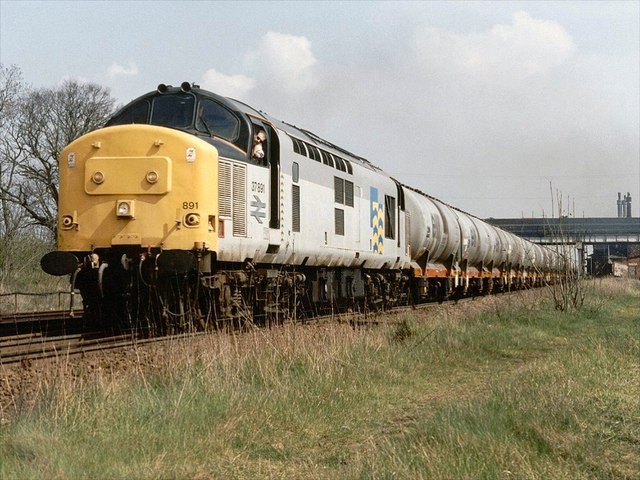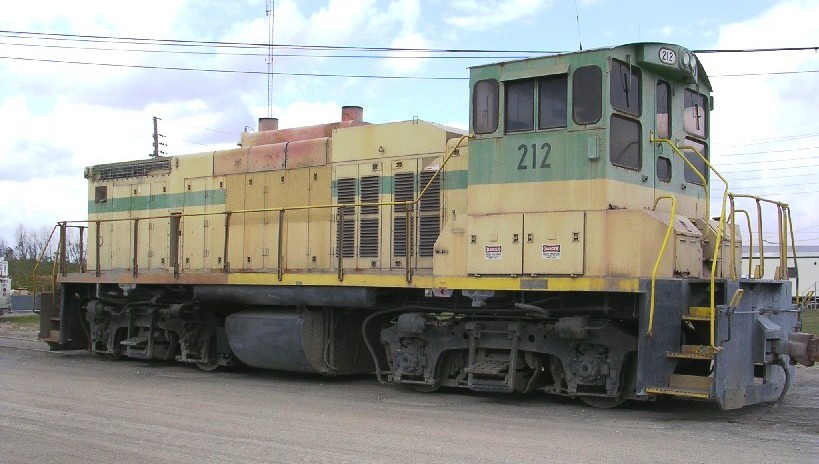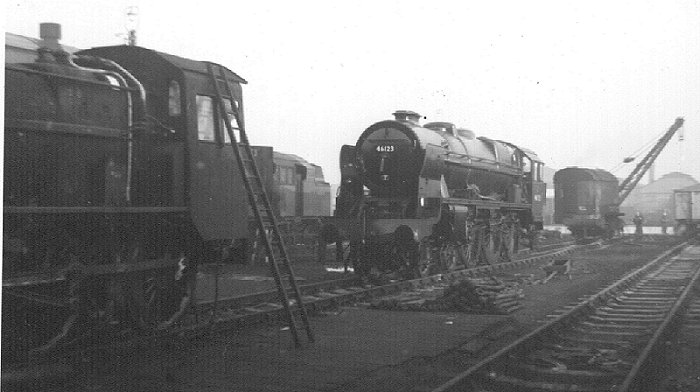|
Railfreight Distribution
Railfreight Distribution was a sub-sector of British Rail, created by the division in 1987 of British Rail's previous Railfreight sector. It was responsible for non-trainload freight operations, as well as Freightliner and Intermodal services. In its early years, the division was occasionally referred to as Speedlink Distribution. It was later responsible for freight operations through the Channel Tunnel. History In the 1980s, freight traffic on the railway was in decline, due to a mixture of increased competition from road transport, a shrinking network that had reduced rail's reach and a decline in the domestic manufacturing industry, reducing internal demands for raw materials and transport of finished product for export. By the late 1980s, British Rail In October 1988, took three troublesome divisions of their freight operations; Speedlink ( wagonload), Freightliner ( Container), Railfreight International (International traffic) and merged them into one entity, Railfreigh ... [...More Info...] [...Related Items...] OR: [Wikipedia] [Google] [Baidu] |
Railfreight
Railfreight was a sector of British Rail responsible for all freight operations on the British network. The division was created in 1982 when BR sought to assign particular stock and management to the evolving requirements of freight traffic. History Railfreight existed as a single unit from 1982 until 1987 as the rail freight division of British Rail. In 1987 BRs freight operations were further divided according to the type of train operated and material carried; the Trainload Freight division and its sub-sectors handled unit trains of coal, metal, aggregates, oil or petroleum, LPG, petro-chemicals, and construction materials, Railfreight Distribution handled intermodal and non-unit train work, and channel tunnel freight. Activities which were not assigned to one of the new ''Trainload Freight'' or ''Railfreight Distribution'' sub-sectors were then continued under the Railfreight General banner, Railfreight General was dissolved in 1989, its limited responsibilities being ... [...More Info...] [...Related Items...] OR: [Wikipedia] [Google] [Baidu] |
Europe
Europe is a large peninsula conventionally considered a continent in its own right because of its great physical size and the weight of its history and traditions. Europe is also considered a subcontinent of Eurasia and it is located entirely in the Northern Hemisphere and mostly in the Eastern Hemisphere. Comprising the westernmost peninsulas of Eurasia, it shares the continental landmass of Afro-Eurasia with both Africa and Asia. It is bordered by the Arctic Ocean to the north, the Atlantic Ocean to the west, the Mediterranean Sea to the south and Asia to the east. Europe is commonly considered to be separated from Asia by the watershed of the Ural Mountains, the Ural River, the Caspian Sea, the Greater Caucasus, the Black Sea and the waterways of the Turkish Straits. "Europe" (pp. 68–69); "Asia" (pp. 90–91): "A commonly accepted division between Asia and Europe ... is formed by the Ural Mountains, Ural River, Caspian Sea, Caucasus Mountains, and the Blac ... [...More Info...] [...Related Items...] OR: [Wikipedia] [Google] [Baidu] |
Trainload Freight
Trainload Freight was the sector of British Rail responsible for trainload freight services. The division was subdivided into four sub-sectors; coal, petroleum, metals and construction. It was formed in 1988 from the trainload operations of British Rail's Railfreight division. The company existed until 1994, when, as part of the privatisation process of British Rail, it was split into three separate companies by region: Load-Haul, Mainline Freight and Trans-Rail. History Trainload Freight (TLF) was created in 1988 as the sector of British Rail responsible for operating unit trains. The division was subdivided into four sub-sectors according to cargo carried: Coal, Construction, Metals, and Petroleum. Other wagonload freight activities and containerised freight were organised in the Railfreight Distribution (RfD) division at the same time. The trainload business represented approximately 80% of British Rail's total revenue from freight, and 90% of freight traffic by mass. ... [...More Info...] [...Related Items...] OR: [Wikipedia] [Google] [Baidu] |
90021 At York
9 (nine) is the natural number following and preceding . Evolution of the Arabic digit In the beginning, various Indians wrote a digit 9 similar in shape to the modern closing question mark without the bottom dot. The Kshatrapa, Andhra and Gupta started curving the bottom vertical line coming up with a -look-alike. The Nagari continued the bottom stroke to make a circle and enclose the 3-look-alike, in much the same way that the sign @ encircles a lowercase ''a''. As time went on, the enclosing circle became bigger and its line continued beyond the circle downwards, as the 3-look-alike became smaller. Soon, all that was left of the 3-look-alike was a squiggle. The Arabs simply connected that squiggle to the downward stroke at the middle and subsequent European change was purely cosmetic. While the shape of the glyph for the digit 9 has an ascender in most modern typefaces, in typefaces with text figures the character usually has a descender, as, for example, in . The mod ... [...More Info...] [...Related Items...] OR: [Wikipedia] [Google] [Baidu] |
Switcher
A switcher, shunter, yard pilot, switch engine, yard goat, or shifter is a small railroad locomotive used for manoeuvring railroad cars inside a rail yard in a process known as ''switching'' (US) or ''shunting'' (UK). Switchers are not intended for moving trains over long distances but rather for assembling trains in order for another locomotive to take over. They do this in classification yards (Great Britain: ''marshalling yards''). Switchers may also make short transfer runs and even be the only motive power on branch lines and switching and terminal railroads. The term can also be used to describe the workers operating these engines or engaged in directing shunting operations. Switching locomotives may be purpose-built engines, but may also be downgraded main-line engines, or simply main-line engines assigned to switching. Switchers can also be used on short excursion train rides. The typical switcher is optimised for its job, being relatively low-powered but with a hi ... [...More Info...] [...Related Items...] OR: [Wikipedia] [Google] [Baidu] |
Crewe Works
Crewe Works is a British railway engineering facility located in the town of Crewe, Cheshire. The works, which was originally opened by the Grand Junction Railway in 1840, employed around 7,000 to 8,000 workers at its peak. In the 1980s, a lot of the engineering works were closed. Much of the site has been redeveloped but the remaining parts are owned and operated by French-owned multinational rolling stock manufacturer, Alstom SA. During the late 19th century, the London and North Western Railway used Crewe Works to produce many famous locomotives such as the Webb Jumbo class and the compounds, the Whale Experiment and Precursor classes, and the Bowen-Cooke Claughtons. In particular, Whale's 1912 superheated G1 Class developed from a locomotive introduced by Webb in 1892, lasted, in many cases until 1964, near the end of steam in 1968. After grouping, the works were taken over by London, Midland and Scottish Railway which was the successor to the LNWR. It was d ... [...More Info...] [...Related Items...] OR: [Wikipedia] [Google] [Baidu] |
Tinsley Motive Power Depot
Tinsley Motive Power Depot, latterly Tinsley Traction Maintenance Depot ( TMD), was a railway depot in Tinsley, South Yorkshire, near Sheffield. Access by road was from Brinsworth, near Rotherham. The depot was situated on the freight line between Treeton Junction and the A631 Shepcote Lane. History The depot was built as part of the Sheffield district rail rationalisation plan of the 1960s opening in April 1964 replacing Millhouses, Grimesthorpe, Darnall and Canklow steam sheds. It was situated adjacent to, but at a higher level than, the new Tinsley Marshalling Yard alongside the Sheffield District Railway. Diesel locomotives had been stationed at the old steam shed at Grimesthorpe until the new facilities were completed and the locomotives were moved to their new home. The site also included a small electric locomotive servicing shed at the south end of the Secondary Yard, replacing the facilities at Darnall. Diesel railcars, which had been serviced at Darnall, were moved ... [...More Info...] [...Related Items...] OR: [Wikipedia] [Google] [Baidu] |
European Passenger Services
Eurostar International LimitedCompanies House extract company no 2462001 Eurostar International Limited formerly Eurostar (UK) Limited formerly European Passenger Services Limited (EIL) is the operating the international train services between , , |
British Rail Class 92
The British Rail Class 92 is a dual-voltage electric locomotive, which can run on 25 kV AC from overhead wires or 750 V DC from a third rail. It was designed specifically to operate services through the Channel Tunnel between Great Britain and France. Eurotunnel indicates the Class 92 locomotive as the reference for other locomotives which railway undertakings might want to get certified for usage in the Channel tunnel. Locomotives of this type are operated by GB Railfreight/ Europorte 2 and DB Cargo UK. In France, a number were also owned and operated by SNCF; these were classified as CC 92000 on French railways. The Class 92 was intended as a mixed-traffic locomotive both for hauling international freight trains and the ill-fated, never introduced ''Nightstar'' passenger sleeper trains though the Channel Tunnel. Since introduction, the fleet was exclusively allocated to freight; however, in March 2015, six locomotives owned by GB Railfreight have begun passenger oper ... [...More Info...] [...Related Items...] OR: [Wikipedia] [Google] [Baidu] |
British Rail Class 90
The British Rail Class 90 electric locomotives were built for mixed-traffic duties, operating from overhead lines and produce . They weigh 84.5tonnes and can typically achieve a top speed of . The Class 90 is a modernised derivative of the preceding Class 87 locomotive, having been originally designated as the ''Class 87/2''. During the 1980s, British Rail Engineering Limited (BREL) had submitted an offer to build 25 examples to replace various aging electric locomotives, including the Class 81, Class 82, Class 83, Class 84 and Class 85. It was selected over numerous rival proposals, including the InterCity 225 and the Class 89; the type was manufactured by BREL at Crewe Works between 1987 and 1990. The Class 90 was introduced to service during the closing years of British Rail, being used for both passenger services and freight trains alike. Following the privatisation of British Rail, the type has served with various operators, including Greater Anglia, Virgin Tra ... [...More Info...] [...Related Items...] OR: [Wikipedia] [Google] [Baidu] |
British Rail Class 87
The British Rail Class 87 is a type of electric locomotive designed and built by British Rail Engineering Limited (BREL) between 1973 and 1975. A total of thirty-six locomotives were constructed, to work passenger and freight services over the West Coast Main Line (WCML). The type was developed in response to the need to add extra capacity to the electric traction fleet operated by British Rail (BR), in addition to the desire to introduce a higher performance electric locomotive than the existing Class 86, numerous aspects of which being incorporated into its design. The Class 87 fleet was operated as the flagships of British Rail's electric locomotive fleet until the late 1980s, at which point the Class 90, an improved derivative of the Class 87, started to come on stream. As a consequence of the privatisation of British Rail during the mid 1990s, all but one of the Class 87s were transferred to Virgin Trains. Under this operator, the type continued their passenger duties u ... [...More Info...] [...Related Items...] OR: [Wikipedia] [Google] [Baidu] |
British Rail Class 86
The British Rail Class 86 is a class of electric locomotives built during the 1960s. Developed as a 'standard' electric locomotive from earlier prototype models, one hundred of these locomotives were built from 1965 to 1966 to haul trains on the then newly electrified West Coast Main Line (WCML) from London Euston to Birmingham, , Liverpool, Manchester and later Glasgow and . Introduction of the class enabled the replacement of many steam locomotives, which were finally withdrawn by British Rail in 1968. Under the earlier BR classification system, the type was given the designation AL6 (meaning the sixth design of AC locomotive) and locomotives were numbered E3101-E3200. In 1968, this was changed to Class 86 when British Rail introduced the TOPS classification system. The class was built to haul passenger and freight trains alike on the West Coast Main Line, however some members of the class also saw use on the Great Eastern Main Line (GEML) between and , after that line was ... [...More Info...] [...Related Items...] OR: [Wikipedia] [Google] [Baidu] |






.jpg)
